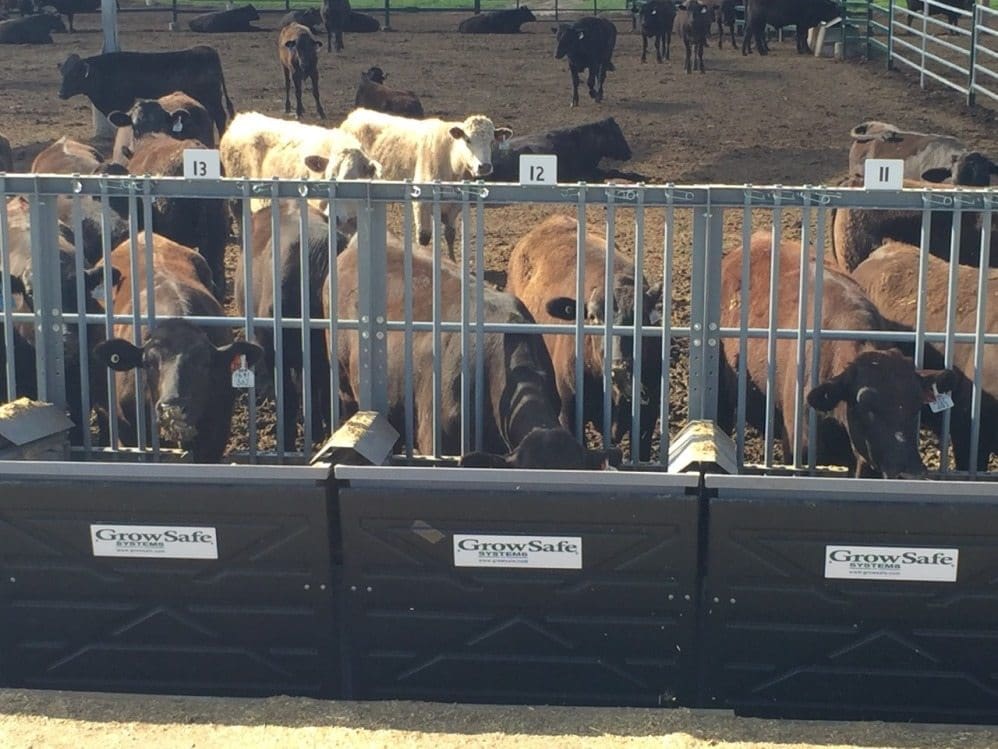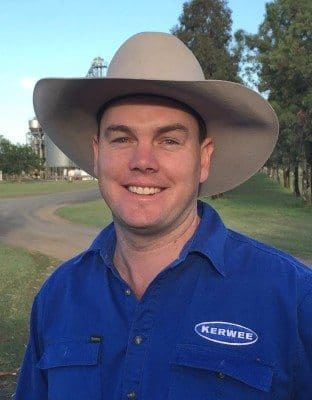
Wagyu F1 steers in the Net Feed Intake sire test at Kerwee feedlot
WAGYU genetic progress is set to benefit immensely from Australia’s first sire progeny test where net feed intake is assessed in a commercial feedlot situation.
Australian Wagyu Association and Kerwee Lot Feeders on Queensland’s Darling Downs have developed a comprehensive program with the first intake of 180 head representing nine sires in the feedlot since August 4.
Kerwee has installed GrowSafe feed conversion measurement bins in two pens with a total capacity of 180 head. Three intakes a year can be assessed.
The Australian Agricultural Co’s Goonoo feedlot in Central Queensland uses a similar feed testing station, but that is used exclusively for company-owned cattle. The Kerwee feed test staion is the first example for use by the broader industry.
The first intake are all from Darren Hamblin’s Strathdale Wagyu operation in Central Queensland, who is keen to quickly discover the genetic abilities, especially for feed efficiency, of a team of high indexing sires.
“We are keen to support Kerwee as well as the industry which is set to gain so much from this project,” said Mr Hamblin, who has an extensive growth and carcase database on his cattle.
“This NFI testing will fill in a missing part of the financial puzzle. Until now we have been able to determine growth and carcase quality but this adds another element,” he said.
“We could have sires that are equal for growth and carcase traits, but we have not been able to identify which one converts feed to weight more efficiently.”
Initial data indicated that weightgains in the trial were pretty much in line with what Mr Hamblin’s previous data was showing.
Making this first intake of cattle even more interesting for the Wagyu industry, some widely-used industry link sires are among the nine sires with progeny in the first cohort.
To participate in the program, an AWA member must supply at least five progeny from each of two Wagyu sires. The progeny need to be from the same property, the same sex and about the same age.
Next intake in October
The next intake is at the end of October, with entries required by the end of September. Each intake is restricted to 180 head and bookings are being taken now.
The first cohort of 180 head will have been on feed for 100 days and the second cohort will be settling in the paddock when a Wagyu field day/workshop will visit Kerwee on Monday November 14 where the program will be explained and demonstrated in detail.

Kerwee feedlot manager Steve Martin
Kerwee is responsible for a 28-day settling in period, NFI testing over 70 days, custom feeding for 450 days, regular weighing and provision of data to owners and the AWA to use in Breedplan EBV generation.
Carcase analysis will include digital imaging through a camera specially developed in Japan to assess Wagyu-type carcases for eye muscle area, marbling percentage and marbling fineness with an accuracy much greater than through visual assessment.
AWA technical services manager Carel Teseling said because Wagyu were longfed on grain – often for 350 days or more, feed efficiency was a crucial trait of commercial interest.
“High-ranking Wagyu bulls are in demand and the early-adopters of this new testing procedure to identify superior sires, will be the ones to benefit,” Mr Teseling said.
He used as an example the sale of 10 straws of semen for the breed’s leading Fullblood Terminal Index sire, which sold at the 2016 Wagyu Conference for $30,500 or $3050/straw. The buyer was from overseas.
“The industry is hungry for proven genetics”, he said.
Kerwee feedlot general manager Steve Martin said the data collection was important to his company, which specialises in longfed high quality beef production, where efficient cost of gain was crucial to the operation.
“Feed efficiency can vary by up to 15pc between animals, and in the case of a Wagyu on feed for 400 days, can result in 6pc or $240/head difference in current production costs,” Mr Martin said.
- Entry forms for the next intake of NFI testing at Kerwee are available here.
- More information can be obtained from Steve Martin on 0437 569 765 or Carel Teseling on 0439 368 283.
Source: AWA



Genetic linkage accross contemporary groups is critically important for Breedplan analysis. That is exactly why the current intake from a single property, representing large numbers of progeny from industry benchmark sires like Itoshigenami, Itoshigefuji, World K’s Michifuku and World K’s Michisuru, is such a significant start to this project.
can’t compare the data for breedplan if the calves were born in different herds, born more than 45 days apart, of different sex, received different management on farm, castrated on different dates, etc… best suited to producers with larger lines of cattle, and they can use the fcr data to underpin other breeding decisions.